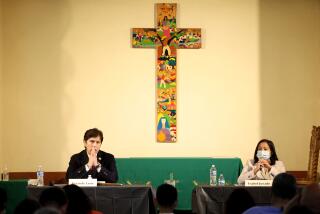Secession Too Big to Fit at 1 Round Table
- Share via
Los Angeles Police Chief Bernard Parks first called in to confirm. Then he called in to cancel.
That’s too bad, because now the Cal State Northridge Center for Southern California Studies is scrambling for a substitute, someone who could explain police deployment practices that the Valleyistas love to hate.
Yes, the LAPD needs a rep on this round table, right alongside William McCarley. As the former chief of the DWP and the city’s former chief legislative analyst, McCarley is qualified to address a variety of thorny questions raised by the proposed division of Los Angeles.
“Secession: What Does It Mean for Us? A Citywide Forum” is the title of the symposium scheduled for 1:30 p.m. April 2 at the CSUN Performing Arts Center. The idea, says political science professor Matthew Cahn, director of the Southern California studies center, is to provide a neutral, nonpartisan discussion.
“We want to shed more light and less heat on what is obviously a very heated issue,” says former Councilwoman Joy Picus, an organizer and participant.
Only one participant, Valley VOTE leader Richard Close, has been outspokenly partisan on secession--and he, of course, is all for it. This isn’t to suggest other participants lack opinions. Picus, for example, says she opposes secession, but she hasn’t crusaded against it.
More light and less heat is a fine idea, especially since secession was moved back to the front burner of local politics last week when results of a poll indicated strong support among likely Valley voters for dividing Los Angeles into two cities.
The poll, financed by Valley movers-and-shakers Bert Boeckmann and David Fleming, was a tasty bit of home cooking. I say this for two reasons. First, an actual vote on secession would require approval of voters citywide, not just the Valley. Second, to read the poll questions is to understand it was an attempt to both influence and measure opinion at the same time. Politics is, after all, politics.
Voters were asked, for example, to rate on a scale of 1 to 5 the importance of various secession selling points. Among the statements they were asked to judge was this: “The Valley has about one police officer per 1,000 residents, compared to two officers (per 1,000) for the rest of Los Angeles.”
Now there’s a stat that gets people’s attention. And that’s why Parks or one of his deputies should be there to explain LAPD deployment strategy.
Picus, who represented parts of the West Valley on the City Council for 14 years before her former field deputy Laura Chick defeated her 4 1/2 years ago, is a veteran of many debates on police deployment. There are, she suggests, more meaningful ways of measuring police service, such as response time and officers-per-crime. But it’s the LAPD who needs to make the case.
So, yes, the panel needs officials like Parks and McCarley who are well-versed in the city’s infrastructure.
The panel also includes a representative from the Board of Equalization to tackle tax issues. A rep from the city’s elected Charter Reform Commission can address its work, and the head of LAFCO--not a comedy club, but the Local Agency Formation Commission--will explain the secession process.
Organizers also took care to bring in representatives of groups that, unlike Valley VOTE, have not raised their voices in the secession debate. In selecting participants, Picus says, “We wanted a panel that looks like the city and looks like the Valley.”
So Irene Tovar, executive director of the Latin American Civic Assn., is expected to be there, along with Rev. Zedar Broadous of the Valley chapter of the NAACP, Ron Wakabayashi of the county Human Relations Commission, and Xandra Kayden of the L.A. League of Women Voters.
Racial and ethnic questions “are a major issue the secession movement has done everything to avoid,” says Cahn. “One can’t leave out ethnic politics in Los Angeles.”
Secessionists have done little to address racial and ethnic questions except to point out examples of diversity in their ranks and to argue the Valley’s own drastic demographic changes should be enough to defuse charges of “white flight.”
But if the movement gains traction, other questions will be raised--such as the prospect that secession could leave L.A.’s most troubled neighborhoods with fewer cops and more crime. Regardless of the Valley’s diversity, racial politics will become a major issue. Does Los Angeles really want to scratch at those scabs?
So while symposium organizers say the idea is to come up with a dispassionate discussion on a hot issue, one look at the composition of the panel should serve as a cautionary sign.
With another look you might notice that something is conspicuously absent.
Nobody is on the panel to represent the public school system. Chief Parks was invited, but Supt. Ruben Zacarias wasn’t. There are only so many topics that can be covered in a symposium, so this was limited to city governance. Next year, Cahn points out, the Center for Southern California Studies will tackle the question of “community”--or rather, the sense that it is lacking--and schools will be an important element of that discussion.
Oh, well. So many questions, so few symposia. But the fact is, with crime down for five straight years and the economy bustling ahead, the Valleyistas’ favorite survey suggests that people are much, much more concerned about the low marks of neighborhood schools than the improving grades of the local police.
Strange, then, that the schools aren’t on the front burner.
Scott Harris’ column appears Tuesdays, Thursdays and Sundays. Readers may write to him at The Times’ Valley Edition, 20000 Prairie St., Chatsworth, CA 91311, or via e-mail at [email protected] Please include a phone number.
More to Read
Sign up for Essential California
The most important California stories and recommendations in your inbox every morning.
You may occasionally receive promotional content from the Los Angeles Times.










